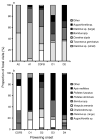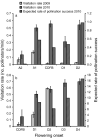Pollinator effectiveness varies with experimental shifts in flowering time
- PMID: 22690631
- PMCID: PMC3761069
- DOI: 10.1890/11-0967.1
Pollinator effectiveness varies with experimental shifts in flowering time
Abstract
The earlier flowering times exhibited by many plant species are a conspicuous sign of climate change. Altered phenologies have caused concern that species could suffer population declines if they flower at times when effective pollinators are unavailable. For two perennial wildflowers, Tradescantia ohiensis and Asclepias incarnata, we used an experimental approach to explore how changing phenology affects the taxonomic composition of the pollinator assemblage and the effectiveness of individual pollinator taxa. After finding in the previous year that fruit set varied with flowering time, we manipulated flowering onset in greenhouses, placed plants in the field over the span of five weeks, and measured pollinator effectiveness as the number of seeds produced after a single visit to a flower. The average effectiveness of pollinators and the expected rates of pollination success were lower for plants of both species flowering earlier than for plants flowering at historical times, suggesting there could be reproductive costs to earlier flowering. Whereas for A. incarnata, differences in average seed set among weeks were due primarily to changes in the composition of the pollinator assemblage, the differences for T. ohiensis were driven by the combined effects of compositional changes and increases over time in the effectiveness of some pollinator taxa. Both species face the possibility of temporal mismatch between the availability of the most effective pollinators and the onset of flowering, and changes in the effectiveness of individual pollinator taxa through time may add an unexpected element to the reproductive consequences of such mismatches.
Figures




References
-
- Abu-Asab MS, Peterson PM, Shetler SG, Orli SS. Earlier plant flowering in spring as a response to global warming in the Washington, D.C., area. Biodiversity Conservation. 2001;10:597–612.
-
- Alarcón R, Waser NM, Ollerton J. Year-to-year variation in the topology of a plant–pollinator interaction network. Oikos. 2008;117:1796–1807.
-
- Beattie AJ. Pollination mechanisms in Viola. New Phytologist. 1971;70:343–360.
Publication types
MeSH terms
Grants and funding
LinkOut - more resources
Full Text Sources
